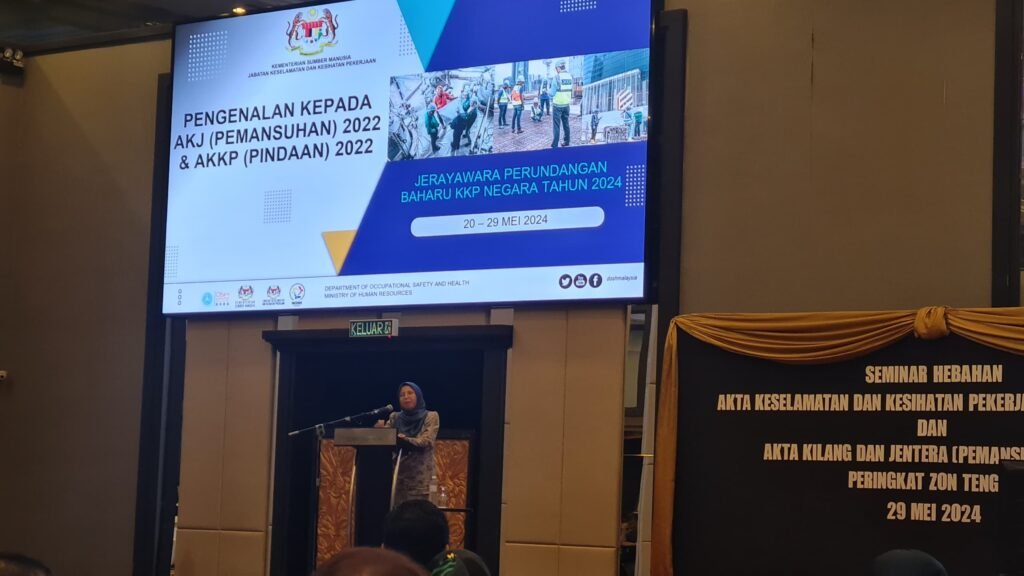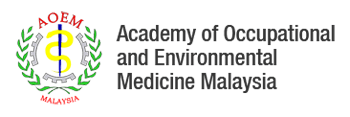On May 29, 2024, a significant event was held at the Concord Hotel in Shah Alam to discuss the recent amendments to the Occupational Safety and Health Act 1994 (OSHA) and the repeal of the Factories and Machinery Act 1967 (FMA). This roadshow was organised by the Selangor State Department of Occupational Safety and Health for the Central Region. The aim of the roadshow was to inform and educate stakeholders about the key changes and their implications for workplace safety and health in Malaysia. DOSH invited representatives from industries through their association. Dr Abu Hasan, the President and Prof Dr Victor Hoe, the Censor in Chief of the Academy of Occupational and Environmental Medicine Malaysia (AOEMM) attended the event as part of the delegation from the Malaysian Federation for Occupational Safety and Health (MyFOSH). MyFOSH is a federation of occupational safety and health association and societies in Malaysia. Dr Abu Hasan was also the current Chairman of MyFOSH.

The Occupational Safety and Health (Amendment) Act 2022 introduces several significant changes to the existing Occupational Safety and Health Act 1994 (OSHA 1994) and the repeal of the Factory and Machinery Act 1967 in Malaysia. These amendments came into effect on June 1, 2024, and will have substantial implications for businesses and occupational health doctors.


The objective of the amendment and the repeal includes:
- to strengthen the concept of self-regulation
- to ensure legislation meets the advancement in technology
- to standardise the existing legislations
- to ratify the relevant International Labour Organisation Conventions
- to improve the weakness of current and
- to increase the effectiveness of enforcement
Key Changes in the OSHA 1994 Amendment 2022
1. Extended Scope and Applicability
The amended OSHA now applies to all places of work throughout Malaysia, including public services and statutory authorities, with few exceptions such as domestic servants, armed forces, and work on board ships governed by the Merchant Shipping Ordinance 1952. This broadening of scope ensures that more workplaces are required to comply with OSHA regulations, promoting a safer working environment across various industries.
2. Increased Penalties
Penalties for non-compliance have been significantly increased. For instance, the maximum fines for employers violating their duties have been raised from RM50,000 to RM500,000. Penalties for manufacturers’ duties on plant and materials at the workplace have also increased from RM20,000 to RM200,000. These higher penalties are intended to serve as a deterrent against neglecting occupational safety and health regulations.
3. New Responsibilities for Employers and Principals
- Risk Assessments: Employers, self-employed persons, and principals are now required to conduct and implement risk assessments to enhance accountability for any omissions, liabilities, or defaults.
- Emergency Procedures: Employers must develop and implement procedures for dealing with emergencies at work.
- Occupational Safety and Health Coordinators: Employers with five or more employees must appoint an occupational safety and health coordinator to oversee and manage all occupational safety and health matters at the workplace.
- Training Requirements: The Minister of Human Resources can mandate specific groups of individuals to attend occupational safety and health training courses conducted by registered training providers.
4. Protection for Employees
Employees now have the statutory right to remove themselves from imminent danger at work if the employer fails to take action after being informed of the danger. This provision aims to protect employees from serious risks of death or injury. Employers are prohibited from taking any action against employees who make complaints about health risks or report occupational diseases to the Director General.
5. Integration of OSHA and FMA
The Factories and Machinery Act 1967 (FMA) has been repealed, and its provisions have been integrated into the amended OSHA. This consolidation aims to create a comprehensive health and safety legislation applicable to all industries.
Impact on Occupational Health Services
Enhanced Role and Responsibilities
Occupational health doctors will play a crucial role in ensuring compliance with the new regulations. They may be involved in conducting health risk assessments, developing safety protocols, and providing training on occupational health and safety. The protection for employees making health-related complaints or reports will likely increase the interaction between occupational health doctors and regulatory authorities, ensuring that health risks are promptly addressed.
Increased Demand for Services
With the broader applicability of OSHA and the emphasis on proactive risk management, there may be an increased demand for occupational health services. Businesses will need expert advice and support to navigate the new regulatory landscape and ensure the well-being of their employees.
In summary, the OSHA 1994 Amendment 2022 introduces comprehensive changes aimed at enhancing workplace safety and health across Malaysia. These changes will require businesses to adopt more rigorous safety measures and increase the role of occupational health doctors in maintaining compliance and protecting employee health.
Article written by Dr Victor C W Hoe, AOEMM Council Member.

